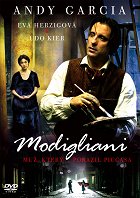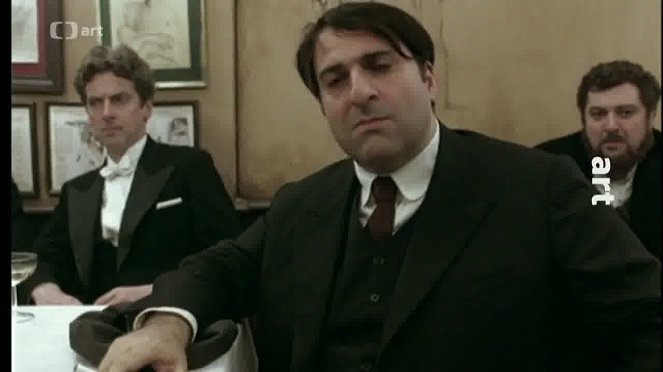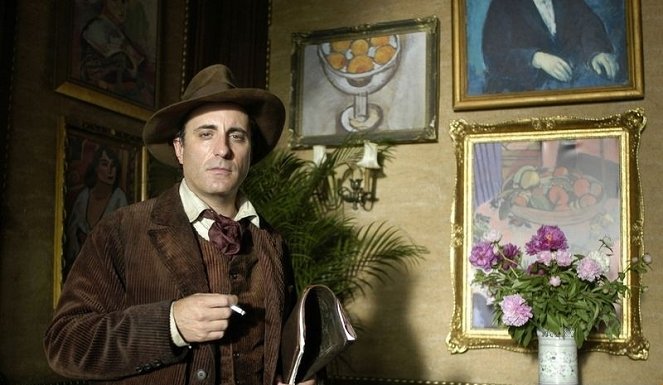Režie:
Mick DavisScénář:
Mick DavisKamera:
Emmanuel KadoshHudba:
Guy FarleyHrají:
Andy Garcia, Elsa Zylberstein, Omid Djalili, Hippolyte Girardot, Eva Herzigová, Susie Amy, Peter Capaldi, Udo Kier, Miriam Margolyes, Mihai Gruia Sandu (více)VOD (1)
Obsahy(1)
Film vypráví o soupeření italského malíře Modiglianiho s jeho největším rivalem Pablem Piccasem. Oba dva se rozhodnou zúčastnit se pařížské výstavy a namalují velkolepá plátna. S vítězstvím je spojena nemalá suma peněz. Vyhrát ale může jen jeden. Který z nich to bude? Piccasovu manželku ztvárnila modelka českého původu Eva Herzigová. (oficiální text distributora)
(více)Videa (1)
Recenze (70)
Amedeo Modigliani měl zajímavý život a tohle nám také film poutavě přednáší. Skvělý sountrack doprovází charismatického Andy Garciu, skvělou Elsu Zybelstein a přesvědčivého Omida Djaliliho v roli Pabla Picassa. Za zmínku ještě určitě stojí Modiho vidiny (zvlášť ta v blázinci); jednu ke konci uvidí i sám Picasso. Umělci hold v sobě mají vždy trochu šílenství. Nejméně 4 hvězdy si tento film určitě zaslouží ;-) ()
Točit filmy o lidech, kteří skutečně žili, s sebou nutně přináší ten fakt, že si spousta diváků udělá o té osobě obraz podle toho, co vidí. Takovým markantním příkladem je Formanův Amadeus, v němž jsou Mozart a Salieri zpodobeni takovými, jakými ve skutečnosti vůbec nebyli. Jaký byl Modigliani, to nevím a určitě ho nebudu mít zafixovaného takového, jakým byl v tomto filmu, který sice nepatří ke skvostům světové kinematografie, nicméně určitě patří k těm kvalitnějším a mohl by některé diváky postrčit k tomu, aby se začali trochu víc zajímat o Modiglianiho dílo. Herecké výkony jsou na vysoké úrovni, akorát mi nejde na rozum, proč byl do role Pabla Piccasa vybrán tak tlustý herec, protože Piccaso tlustý nebyl, naopak měl až do pozdního věku hodně sportovní figuru. ()
Historicky i náladově zpracování nedůsledné, ujímající se námětu s až diskutabilní uvolněností, ale jinak krásné. Totiž pochopíme-li ho jako pouhou biografickou inspiraci, jejíž úlohou není seznámit nás s dokumentárně přesným obrazem Modiglianiho, ale na volně pojatém námětu předvést možné konsekvence jeho příběhu. Pravda ovšem, že tvůrci to s důrazem na plasticitu vůči faktické předloze indiferentního materiálu přehnali, když nám pustili Édith Piaf a dokonce ještě ahistoričtější formy doprovodu; nadbytečný je i zuřivý gestikulační afekt prostupující scénu improvizovaného uměleckého soutěžení (jako by opravdu malovat bylo totéž, co dělat někomu divadlo); korunovali to presentacemi fiktivních obrazů, které do vlastní Modiglianiho práce nikdy nepatřily, z nichž nejnevhodnější, ač zároveň nejkrásnější, je ten poslední (sice model Jeanne patřil i k těm posledním, ale mám za to, že se snad nedostala jejich řada ani do posledního géniova měsíce - poslední datace jsou ještě z roku 1919 -, přičemž poslední dva obrazy jsou jeden portrét Maria Varvogliho a druhý autoportrét, jimž předchází, coby číslo 335., portrét Jeanne Hébuterne). Přepjaté. Příběh, který končí tím, že zemře ani středního věku se nedoživší génius, načež příštího dne se rozhodne skončit život s ním těhotná žena, natolik nemá nouzi o dramatičnost, že překračovat ji s takovou nadsazenou fabulací, jakož i výrazovou hypertensí vychází kontraproduktivně. A nakonec i tím, že ve snímku byly tak hojně zastoupeny nedecentně smyšlené situace, ona doprovodná falsa padla ději víc, než by mu snad padla pravá díla Modiglianiova. Zvláště ten poslední obraz je dílem velmi šikovného kopisty, který zkombinoval hned několik typických, arciže simultánně autorem samým nikdy nepoužitých prvků, jak je lze vysledovat z jeho obrazů Jeanne. Kopista čerpaje z jeho stylu založil Jeanne dlaně v klín, s inovací, že se pažemi trochu jako by opírala, oděl ji celou do modrého, zabral ji zepředu lehce nakřivo sedící, se štíhlost krku přebírající hlavou v příklonu a s magneticky vlídným pohledem, jenž je doplněn pozadím teplých barev, tedy ji samozřejmě namaloval tak, jak by ji klidně mohl namalovat sám Modigliani (všechny ty prvky se na jeho obrazech Jeanne i jiných žen tak či onak vyskytují, pouze nikdy dohromady; vybočují snad při uvedené poloze neobvykle živé oči). Garcia tancující kolem Balzacovy sochy filmu hodně pomáhá. Z ODBORNÉHO ČLÁNKU: (John A. Walker, Modigliani, myth and cinema [film review], Jamini, Vol 3, No 2, June 2006, pp. 100-103): „Andy Garcia (b. Havana, 1956, aka Andres Arturo Garcia Menendez, who came to the United States in 1961) played the part of Modigliani in the 2004 film of that name. Garcia, a handsome dark-haired actor has played policemen more than artists, but he was keen to obtain the role.Modig liani, a £10 million international colour film (United Kingdom/Germany/Romania/France/Italy) shot in Bucharest, Romania (for reasons of cheapness) for seven weeks during 2003, was directed and written by Mick Davis. He grew up in Glasgow and read a book about Modigliani when he was aged 12 and confined to bed with asthma. He identified with the artist because he also suffered from with tuberculosis as a child. A French producer called André Djaoui raised most of the finance. The production company was Lucky 7 Productions Ltd., and Garcia, was one of the executive producers. The film was premiered in Canada at the Toronto International Film Festival in September 2004 and first shown in the United States at the Miami Film Festival in February 2005. Hébuterne is poignantly played by the French actress Elsa Zylberstein who resembles Modigliani’s portraits of his mistress, muse and model. Other famous characters from bohemian Paris who appear include Pablo Picasso, Maurice Utrillo, Chaim Soutine, Frida Kahlo, Diego Rivera, Max Jacob, Moïse Kisling, Jean Cocteau and Gertrude Stein (played by the British actress Miriam Margoyles). Members of the film’s Art Department - Daniel Alexandru and Liviu Marcu - supplied sculptures while the paintings were provided by Ion Molete. The film concentrates upon the last year of Modigliani’s life, his love affair with Jeanne and their difficulties in dealing with her disapproving Catholic father and supporting their first baby also named Jeanne. We learn about the anti-Semitism Modi experienced when Jeanne’s father, played by the British actor Jim Carter, makes contemptuous remarks about Jews and there is a flashback to Modigliani’s childhood in Livorno, Tuscany, when his bankrupt family were visited by bailiffs one of whom expressed his surprise that Jews could be poor. There is a departure from naturalism when Modigliani as a boy keeps reappearing in scenes with the adult artist to act as his conscience. Other departures include Modigliani’s alcohol and drug-induced visions of a street parade and an oriental opium den. Initially the film resembles Montparnasse 19 but later departs from it by focusing upon his friendship-cum-rivalry with Picasso. (In fact, the real long-term rival in Picasso’s artistic career was the French painter Henri Matisse.) The two men did know one another – they first met in 1906 – and showed in some of the same exhibitions. In 1915, Modigliani painted Picasso’s portrait and Picasso owned a Modigliani. (In the film, Picasso insults Modi by telling him he was short of canvas one night and so painted over one of his pictures. This, apparently, was a true incident.) It seems Modigliani once criticised the Spaniard’s appearance by saying: ‘Picasso may be talented, but that’s no reason he shouldn’t dress decently.’ According to Picasso’s biographer John Richardson, the Spanish artist, for his part, had some respect for Modigliani as a painter but was impatient with his addictions and determination to be a peintre maudit. (1) Omid Djalili, a portly British-born actor and stand-up comedian of Iranian parentage, plays the egotistical Picasso with verve. Supermodel Eva Herzigova plays his then wife Olga. While Modigliani is the epitome of the artist as failure, Picasso – who is already a financial success and a celebrity (we see him accompanied by an entourage of admirers) – is the epitome of the artist as success. In one episode, Picasso drives Modigliani into the countryside to visit a chateau where the elderly impressionist Auguste Renoir lives in luxury but with hands crippled by arthritis; he is also confined to a wheelchair. (Incidentally, the real Renoir [1841-1919] was one of the first artists to appear in a filmed documentary, which was shot around 1917.) Picasso wants to show his rival that artists need not live in poverty. (In 1918, Modigliani did visit Renoir who received him with kindness but, unlike the film’s version of what happened, the Italian was cold and indifferent.) Modigliani’s sense of pride and artistic integrity prevents him from pleasing sitters (who want thein children depicted without long necks) and potential collectors such as the American newspaper magnate William Randolph Hearst. Garcia effectively conveys the man’s charm and charisma but also his self-destructive arrogance. Davis’s emphasis on the rivalry becomes increasingly absurd and far-fetched as the film unfolds. In one scene set in a café, the two artists confront one another: Modigliani stands toying with a wine bottle while Picasso sits at a table with a revolver. It could be a duel between two macho gunfighters in a Western. There is an (fictional) annual painting competition for a sum of money, which Picasso, Modigliani, Rivera, Kisling, Soutine and Utrillo enter. As the artists work frantically in their studios attacking their canvases, Davis cuts rapidly between them and adds a musical soundtrack with a heavy beat so that the sequence resembles a pop music video. (The music in the film, by British composer Guy Farley, is eclectic and draws upon classical, techno and rap sources.) When the completed paintings are unveiled at a public ceremony the results are ludicrous. Especially bad is a pastiche of a cubist-style portrait by Picasso. Modigliani fails to attend the ceremony because he prefers to drink in a bar. After he fails to pay his bill, the bartender sends two thugs to beat him up. This hastens his death in a hospital ward after which the pregnant Jeanne visits Picasso to reproach him (Picasso is reputed to have died with Modigliani’s name on his lips) and then leaps to her death. Since the lives and fates of the lovers were passionate and tragic enough in reality, there was really no need for the exaggerations, historical inaccuracies, fake pictures, and the embellishments Davis added. In an interview, Davis acknowledged he wanted to entertain mainstream audiences rather than please art-house ones. Viewers will not learn much about Modigliani’s art from this film. For example, although Modigliani dances around a statue of Balzac by Rodin, there was no indication that he was interested in the carving sculptures and, apart from references to the pupil less eyes in a portrait of Jeanne, the distinctive characteristics of his pictorial style were never explained. Some critics praised the passionate intensity of the performances of Garcia and Zylberstein even though the former has a tendency to overact. One audience laughed at Garcia’s over-the-top portrayal of himself in a lunatic’s straightjacket (a dream sequence that followed Modigliani’s visit to an asylum where Utrillo was confined in this way). Garcia’s performance reminded one reviewer of Ed Harris’s inPol lock and another thought Jeanne, herself a painter, was the more interesting character and that the film should have been about her. In the view of Boyd van Hoeij, the film was mediocre, in part because it lacked an angle or overriding theme. Other critics judged it ‘competent’ or ‘disappointing’. Film writer Phoebe Flowers thought it ‘a hideous way to start the Miami Film Festival’ and remarked there was ‘nothing like a terrible film to make you actively loathe all artists’. (2) It is perhaps ironic that while the film was being finished and premiered, a major exhibition of Modigliani’s work subtitled ‘Beyond the Myth’ was being held at New York’s Jewish Museum from May to September 2004. The exhibition, which attracted record crowds, travelled to Toronto in October. In an essay in the book/catalogue accompanying the show, Maurice Berger chastised those earlier art historians, biographers and dealers who fostered Modigliani’s ‘tormented genius’ legend and argued that ‘histrionic, fundamentally anti-intellectual approaches’ turned him ‘into a trivial art historical figure, an artist adored by the public but viewed with condescension by many scholars and curators’. (3) Art critic Robert Hughes has commented that Modigliani represents modern art ‘for people who don’t much like modernism’. (His ‘distortions’ of the human form were not so extreme as Picasso’s. Arguably, Modigliani was a minor, somewhat konservative modernist whose portraits became formulaic. There is no sign in his paintings of the wild, debauched life of the myth.) It seems unlikely that scholarly arguments will end the mythic conception of Modigliani because popular myths, as Davis’s film proves yet once again, have a maddening habit of reasserting themselves no matter how often they are deconstructed.“ () (méně) (více)
Život búrliváka „Modiho“ by poskytol materiál aj na päť ťažkotonážnych filmov. Režisér Mick Davis akoby sa však náročnosti a uhrančivosti ponúkanej látky zľakol a namiesto nervovoparalytickej drámy nám servíruje letný koktejl. Okrem všelijakých sirupov a kociek ľadu je tu síce aj pár kvapiek nefalšovaného absintu, ale na poriadnu opicu to nestačí. Voľné narábanie s faktografiou ešte Davisovi možno tolerovať, viac mi prekáža, že sujet rozbil do nie vždy konzistentnej mozaiky. A ešte viac to, že Modimu upiloval rohy a odstrihol chvost a vtlačil mu skôr podobu romanticky nesvojprávneho rojka nepochopeného dobou a spoločnosťou /čo je stáročia nemenná, petrifikovaná predstava veľkej časti populácie o „tých umelcoch“/. Modi bol nepochybne citlivá dušička, ale aj surovec a grobián /Jeanne by o tom vedela rozprávať celé hodiny/, zmietaný démonmi šialenstva – ale takto ho scenárista skrátka vidieť nechcel - a Andy García by to možno ani nezahral. Neomylnou ranou do čierneho je casting postavy Jeanne Hébuternovej – Elsa Zylberstein je týpek, ako by si ju namaľoval sám Modi. Vo výkonoch dvoch protagonistov – Garcíu a Djalila, je viac teatrálnosti než stotožneného herectva, možno aj preto z filmu kvapká namiesto krvi ľahké červené víno. Kvôli niektorým silným miestam som už takmer siahal po štvrtej hviezdičke, ale viac ako ľahučký nadpriemer to žiaľ, určite nie je... ()
Italsky malir Modigliani (Andy Garcia) versus podstatne slavnejsi a uspesnejsi souper Pablo Picaso. Mimo tento minisouboj o velkou sumu penez, kterou vyhraje nejlepsi predstavene dilo, se divaci dozvi neco malo o tom, kdo to Mogliani byl a jake mel neduhy. Pozorny divak se vsimne ceske krasky (Eva Herzigova). 60% ()
Galerie (25)
Zajímavosti (2)
- Vo filme je počuť známu skladbu od Edith Piaf s názvom "La Vie en Rose". Konkrétne v scéne, kedy ústredné duo tancuje na ulici. Táto skladba bola známa predovšetkým v 40-tych rokoch minulého storočia, no do príbehu filmu nesedí kvôli tomu, že samotná Edith Piaf sa narodila v roku 1915. (MikaelSVK)
- Natáčalo sa v rumunskej metropole Bukurešť, predovšetkým v tamojších filmových štúdiách MediaPro Studios. (MikaelSVK)



Reklama